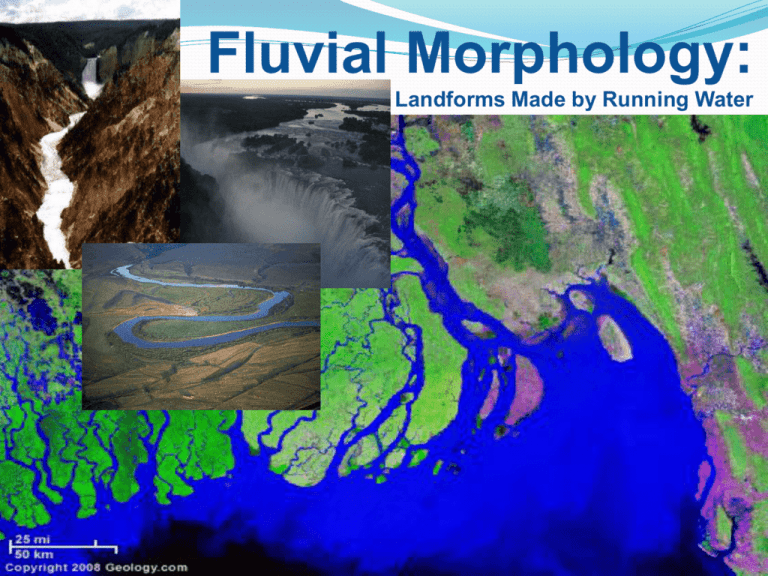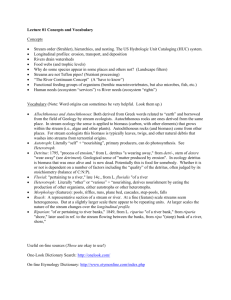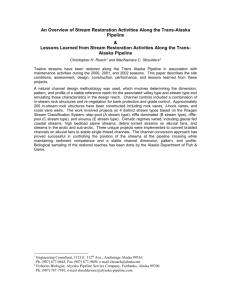17. Fluvial Morphology and Landforms
advertisement

Fluvial Morphology: Landforms Made by Running Water What is the most important geomorphic agent shaping the physical landscape? RUNNING WATER Rivers and Streams What is the work of rivers and streams? Erosion Transportation Deposition Fluvial Morphology: Study of Landforms Made by Running Water FLUVIAL: from the Latin fluvins for ‘running water’ or streamflow SOURCES OF WORLD’S WATER Source Oceans Ice Sheets and Glaciers Ground Water Lakes (Fresh) Inland Seas / Salt Water Lakes Soil Moisture Atmosphere Rivers* % of Supply 97.2 2.15 0.62 0.009 0.008 0.005 0.001 0.0001 * Running water or streamflow is the most significant agent sculpting the Earth’s land surface Sources of stream flow 25 - 40% of total precipitation runs off as storm flow, and becomes stream flow The rest of stream flow comes from groundwater discharge, as base flow River Quiz: http://www.ilike2learn.com/ilike2learn/Rivers/Longest%20Rivers.html Amazon: http://www.youtube.com/watch?v=ta35C488dnE Rills Gullies Streams Stream Order, Drainage Basin, Watershed and Drainage Divide Mississippi-Missouri Drainage Basin Lake Itasca is a small glacial lake, approximately 1.8 square miles in area, in the Lake District of Northwestern Minnesota. It is the source of the Mississippi River. Southern California Watersheds 3-D Drainage System and Stream Model Fig. 17-3, p. 472 Drainage Patterns and Topography The Long Profile of Streams • At their headwaters, the grade of a stream is usually steep • At mid-course, the grade becomes more gently sloping • Near the mouth of the stream, the grade becomes almost flat Stream Gradients Fig. 17-11, p. 480 Stream Stages Streams also show three stages of gradation from the mountains to the sea, with associated erosional and depositional features: Youth Maturity Old Age Stream Stage 1 – Youth Characteristics of Youthful Streams Steep, irregular profile Headward erosion Waterfalls, rapids, and plunge pools River is deepening its channel Cutting into bedrock – Vertical erosion* V-shaped cross-section *Reflects the propensity of streams to try and reach their ultimate base levels (i.e., sea level) or secondary base levels V-shaped Valleys Waterfalls Stream Stage 2 – Mature Valley Characteristics of Mature Valley Streams Valley widening begins Meandering stream lateral erosion + deposition Braided channel deposition (sand bars) Floodplains Meandering Streams Meandering Stream Fig. 17-24a, p. 489 Braided Stream Channel of the Brahmaputra River in Tibet Tectonic Uplift, Stream Rejuvenation and Alluvial Terraces Tectonic Uplift, Downcutting, and the Grand Canyon Stream Stage 3 - Old Age Characteristics of Old Age Streams Wide Alluvial Valley Stage The channel is quite large and U-shaped Stream discharge at a maximum and sediment load composed of finer materials Natural Levees, parallel to the stream channel on both banks Other depositional features, including Delta Floodplain Features Fig. 17-26, p. 491 Mississippi Floodplain Delta http://www.youtube.com/watch?v=AjZLAw_lgZ4&feature=related Large deposit of alluvial sediment located at the mouth or estuary of a stream where it enters a body of standing water, usually a ocean or a lake. Deltas are created when the sediment load carried by a stream is deposited because of a sudden reduction in stream velocity. Delta surface is characterized by distributaries Some deltas, like that of the Nile, have a typical triangular shape, like the Greek letter Mississippi Birdfoot Delta Source: NASA Ganges-Brahmaputra River Delta From Landsat 7 WRS Path 137 Row 44, center: 23.12, 90.37. Image taken 2/28/2000 Fluvial Processes and Landscapes at Different Stream Stages Stage Landscape Processes Youthful Steep hillsides, drainage divides predominant, V-shaped valleys Headward erosion, stream downcutting – vertical erosion Mature Rounded hills, valley walls predominant, graded streams, broad floodplains Lateral erosion, streams adjust to discharge/load Floodplains, ox-bow lakes, deltas and alluvial plains, very low relief Deposition, sluggish stream flow, poor drainage Old age Los Angeles River Now! 2005 Flood








